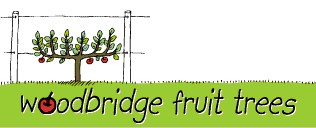No products
 View larger
View larger
Woolly Aphid and Rootstocks
by Bob Magnus | © 2006 Woodbridge Fruit Trees | www.woodbridgefruittrees.com.au
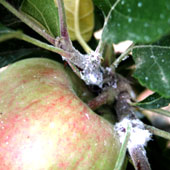
Woolly aphid on an apple tree
We have had enquiries lately about rootstocks resistant to woolly aphid and this article is in response to those enquiries.Woolly aphid is a very destructive insect pest that almost wiped out the apple industry here in Tasmania and in South Africa in the early 1900’s. Before the time of modern pesticides, orchardists were forced to use poisons based on arsenic and nicotine to attempt to control this pest.... with varying results.
Woolly aphids are a tiny burrowing insect with a protective white fluffy cottony covering. Severe infestations look as though there is cotton wool on the branches of the tree.They lay their eggs in the bark of the host and can reproduce quickly, and part of the life cycle is a winged insect allowing them to spread. They suck sap from young branches, buds, leaves, even roots, and can quickly weaken the tree.They also live below ground feeding on the roots.An infestation in rootstock beds is particularly damaging even disastrous.
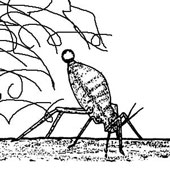
Aphid sucking sap
Mass woolly aphid infection in apple growing areas in the late 19th and early 20th century prompted the use of Northern Spy as a rootstock. It was well known that this American apple variety was resistant to woolly aphids and the apple industry quickly changed to using this as a rootstock. Unfor tunately it wasn’t so successful as far as rootstocks go - the resulting orchard tree must have very good soil conditions, often has a one-sided root system, can be short lived and not easy to propagate. Realising the short comings of Northern Spy the East Malling Research Station in the UK started a breeding program to produce a better woolly aphid resistant rootstock.They crossed Northern Spy with other resistant varieties (eg Ben Davis, Winter Majetin and M793) to produce some 4000 rootstocks to be tested. Only 15 survived the rigorous tests and from those only 2 really became widely used - MM106 and M111.
MM106 became the standard rootstock of our apple industry for 50 or more years. It had and still has all the attributes of an excellent rootstock. Comes into fruit early, does not sucker, produces well in propagating beds, high quality fruit and semi-dwarfing in size. M111 (or M one eleven as it’s known) is a little more vigorous, withstands drought and poorer soils. It’s not quite as precocious as M106.
In the 1960’s Dutch and Belgium apple growers started playing around with dwarfing rootstocks, particularly M9.The combination of M9 rootstock and the variety Jonathan became the standard by which orchards were set. Amazingly precocious and prolific, these intense orchards were producing twice or even three times more fruit per hectare than ever before. But M9 had problems - it cant tolerate anything but rich soil, and has a brittle root system so needs support to prevent the tree falling over. Consequently, many growers switched to M26, a variety introduced from East Malling in 1959. It is slightly more vigorous than M9, better anchored and served the needs of the industry at the time. It has become the standard dwarfing rootstock in Europe and Australia. It’s not sufficiently cold resistant for colder parts of USA and Canada.
In the 80 years since woolly aphid was such a problem, modern insecticides have also been developed, and it’s standard nursery practice to keep woolly aphid under control in propagating beds with vigilance firslty and secondly, systemic insecticides if needed. Consequently woolly aphid at present is not considered a serious pest of modern well maintained orchards and an outbreak can be quickly and locally controlled with a systemic insecticide like ROGOR 40. It should be pointed out that resistance of the Northern Spy derived rootstocks is not passed onto the variety grafted upon them so if an outbreak were to appear above the graft, it would still have to be treated.
Taking all this into consideration, we decided to go for M26 rootstocks when growing our trees. They are precious and prolific, very suited to intense growing systems like espaliers, cordons, spindle bush and ideal for home gardens and small orchards where one can fit quite a few varieties into a small area. It makes much more sense for the home orchard to grow 3 or 4 small trees with a broad spectrum of ripening times in the space of one regular sized tree. M26 also produces high quality fruit. Looking back over the last 15 years or so that we’ve been producing trees upon this rootstock we’d like to think it has been a good choice. It’s amazing to think that the extensive rootstock breeding programmes were a response to a little pest only a couple of millimeters long!
If you’re getting Woolly aphids on your trees, there’s a range of things you can do.
- You can physically squash the fluffy waxy white stuff where the aphids are hiding, although that wont prevent the tiny eggs that have already laid from hatching, nor treat the ones growing on the roots.
- Another approach is to make sure the tree isn’t stressed - plenty of water during dry months along with mulch, manure and a balanced fer tilizer. A healthy tree is much more able to resist insect infestation. Some say growing nasturtiums at the base of the trees can prevent the woolly aphid crawling up.
- Ladybugs, hoverflies (larvae) and Aphidius wasp are predators of woolly aphids. They can be attracted by companion planting - eg Alyssum, Achillea, Lemon Balm, Verbascum, Dill, Coreopsis, Helianthus, Yarrow, Fennel, Coreopsis, Coriander, Foxglove, Statice, Lupin, Scabius, Sunflower. Keeping the garden well mulched and watered will provide moisture for these beneficial bugs.
- Harmless sprays to try include oils: use ECO-OIL (canola oil based with teetree and eucalyptus oil) to smother the insects and dehydrate and kill the eggs. Similarly white oil emulsion or paraffin oil work by suffocating the insects in winter months.A lime sulphur spray (can irritate if got on the skin as it’s quite alkaline) in winter months may help kill the eggs between fissures of the bark.
- Systemic sprays include: Pyrethrum spray is considered low toxic but can also affect benificial insects.
- Systemic spray exist that control wooly aphids. We do not recommend these because of their toxicity. Confidor (BAYER / YATES) is applied as a soil drench and absorbed through the roots of the plant, considered low toxicity but has a withholding period of up to 3 weeks before fruit is picked after treating. Alleged to kill bees. Rogor (SIPCAM) is a systemic organophosphate insecticide used mainly in an agricultural setting, and unavailable in most domestic nurseries because of it’s potency and toxicity. It works well, and there is a withholding period before the fruit can be harvested of at least 7 days. Again, this stuff is toxic.
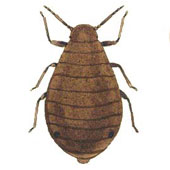
Wingless female (woolly cover removed)
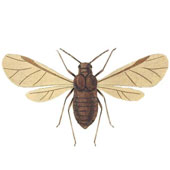
Winged male (woolly cover removed)
This product is no longer in stock
by Bob Magnus | © 2006 Woodbridge Fruit Trees | www.woodbridgefruittrees.com.au

Woolly aphid on an apple tree
We have had enquiries lately about rootstocks resistant to woolly aphid and this article is in response to those enquiries.Woolly aphid is a very destructive insect pest that almost wiped out the apple industry here in Tasmania and in South Africa in the early 1900’s. Before the time of modern pesticides, orchardists were forced to use poisons based on arsenic and nicotine to attempt to control this pest.... with varying results.
Woolly aphids are a tiny burrowing insect with a protective white fluffy cottony covering. Severe infestations look as though there is cotton wool on the branches of the tree.They lay their eggs in the bark of the host and can reproduce quickly, and part of the life cycle is a winged insect allowing them to spread. They suck sap from young branches, buds, leaves, even roots, and can quickly weaken the tree.They also live below ground feeding on the roots.An infestation in rootstock beds is particularly damaging even disastrous.

Aphid sucking sap
Mass woolly aphid infection in apple growing areas in the late 19th and early 20th century prompted the use of Northern Spy as a rootstock. It was well known that this American apple variety was resistant to woolly aphids and the apple industry quickly changed to using this as a rootstock. Unfor tunately it wasn’t so successful as far as rootstocks go - the resulting orchard tree must have very good soil conditions, often has a one-sided root system, can be short lived and not easy to propagate. Realising the short comings of Northern Spy the East Malling Research Station in the UK started a breeding program to produce a better woolly aphid resistant rootstock.They crossed Northern Spy with other resistant varieties (eg Ben Davis, Winter Majetin and M793) to produce some 4000 rootstocks to be tested. Only 15 survived the rigorous tests and from those only 2 really became widely used - MM106 and M111.
MM106 became the standard rootstock of our apple industry for 50 or more years. It had and still has all the attributes of an excellent rootstock. Comes into fruit early, does not sucker, produces well in propagating beds, high quality fruit and semi-dwarfing in size. M111 (or M one eleven as it’s known) is a little more vigorous, withstands drought and poorer soils. It’s not quite as precocious as M106.
In the 1960’s Dutch and Belgium apple growers started playing around with dwarfing rootstocks, particularly M9.The combination of M9 rootstock and the variety Jonathan became the standard by which orchards were set. Amazingly precocious and prolific, these intense orchards were producing twice or even three times more fruit per hectare than ever before. But M9 had problems - it cant tolerate anything but rich soil, and has a brittle root system so needs support to prevent the tree falling over. Consequently, many growers switched to M26, a variety introduced from East Malling in 1959. It is slightly more vigorous than M9, better anchored and served the needs of the industry at the time. It has become the standard dwarfing rootstock in Europe and Australia. It’s not sufficiently cold resistant for colder parts of USA and Canada.
In the 80 years since woolly aphid was such a problem, modern insecticides have also been developed, and it’s standard nursery practice to keep woolly aphid under control in propagating beds with vigilance firslty and secondly, systemic insecticides if needed. Consequently woolly aphid at present is not considered a serious pest of modern well maintained orchards and an outbreak can be quickly and locally controlled with a systemic insecticide like ROGOR 40. It should be pointed out that resistance of the Northern Spy derived rootstocks is not passed onto the variety grafted upon them so if an outbreak were to appear above the graft, it would still have to be treated.
Taking all this into consideration, we decided to go for M26 rootstocks when growing our trees. They are precious and prolific, very suited to intense growing systems like espaliers, cordons, spindle bush and ideal for home gardens and small orchards where one can fit quite a few varieties into a small area. It makes much more sense for the home orchard to grow 3 or 4 small trees with a broad spectrum of ripening times in the space of one regular sized tree. M26 also produces high quality fruit. Looking back over the last 15 years or so that we’ve been producing trees upon this rootstock we’d like to think it has been a good choice. It’s amazing to think that the extensive rootstock breeding programmes were a response to a little pest only a couple of millimeters long!
If you’re getting Woolly aphids on your trees, there’s a range of things you can do.
- You can physically squash the fluffy waxy white stuff where the aphids are hiding, although that wont prevent the tiny eggs that have already laid from hatching, nor treat the ones growing on the roots.
- Another approach is to make sure the tree isn’t stressed - plenty of water during dry months along with mulch, manure and a balanced fer tilizer. A healthy tree is much more able to resist insect infestation. Some say growing nasturtiums at the base of the trees can prevent the woolly aphid crawling up.
- Ladybugs, hoverflies (larvae) and Aphidius wasp are predators of woolly aphids. They can be attracted by companion planting - eg Alyssum, Achillea, Lemon Balm, Verbascum, Dill, Coreopsis, Helianthus, Yarrow, Fennel, Coreopsis, Coriander, Foxglove, Statice, Lupin, Scabius, Sunflower. Keeping the garden well mulched and watered will provide moisture for these beneficial bugs.
- Harmless sprays to try include oils: use ECO-OIL (canola oil based with teetree and eucalyptus oil) to smother the insects and dehydrate and kill the eggs. Similarly white oil emulsion or paraffin oil work by suffocating the insects in winter months.A lime sulphur spray (can irritate if got on the skin as it’s quite alkaline) in winter months may help kill the eggs between fissures of the bark.
- Systemic sprays include: Pyrethrum spray is considered low toxic but can also affect benificial insects.
- Systemic spray exist that control wooly aphids. We do not recommend these because of their toxicity. Confidor (BAYER / YATES) is applied as a soil drench and absorbed through the roots of the plant, considered low toxicity but has a withholding period of up to 3 weeks before fruit is picked after treating. Alleged to kill bees. Rogor (SIPCAM) is a systemic organophosphate insecticide used mainly in an agricultural setting, and unavailable in most domestic nurseries because of it’s potency and toxicity. It works well, and there is a withholding period before the fruit can be harvested of at least 7 days. Again, this stuff is toxic.

Wingless female (woolly cover removed)

Winged male (woolly cover removed)
Reviews
No customer reviews for the moment.
